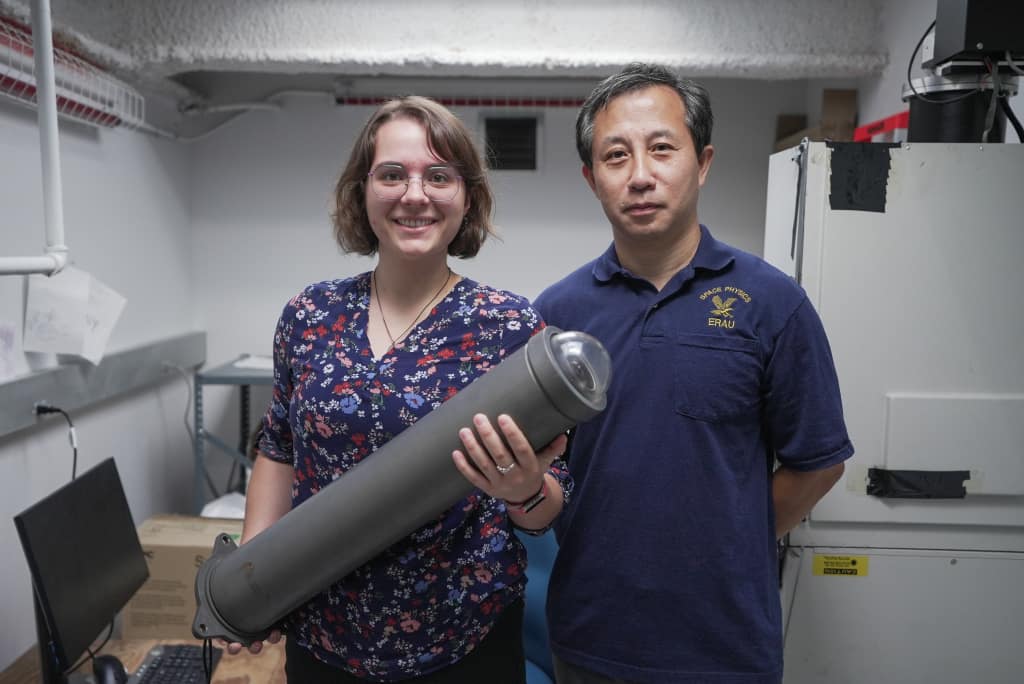Eagle-Built Tech to Provide New Atmospheric Imagery, Thanks to NSF Funding

The National Science Foundation (NSF) has awarded a $1 million grant to Embry-Riddle Aeronautical University’s Dr. Alan Liu to expand a meteor radar network named CONDOR in Chile, enabling the network to provide never-before-achieved continuous measurements of three-dimensional wind structure roughly 70 to 110 kilometers above Earth. The expansion will also provide mapping of atmospheric waves from multiple angles at multiple altitudes in the liminal region between Earth's atmosphere and space.
A professor in the Department of Physical Sciences, Liu was awarded a previous NSF grant in 2019 that supported the deployment of the CONDOR meteor radar network with the transmitter at the Andes Lidar Observatory in Cerro Pachón, Chile, and three receivers at separate sites. The new grant will support the addition of two more receiver sites in Argentina, as well as seven all-sky cameras and a Fabry-Perot Interferometer that provide maps of atmospheric wave motion at multiple altitudes, as well as atmospheric winds, at even higher altitudes (of 200 to 300 kilometers).
“The combination of all of these measurements will give an extremely detailed three-dimensional picture of atmospheric waves that is not yet available anywhere else,” said Liu. “Multiple imagers from multiple sites can be used to reconstruct the three-dimensional atmospheric wave field through complex mathematical algorithms.”
Such information is used to improve models of global circulation, space weather prediction and global satellite navigation systems. The observatory’s location allows Liu and his team to gather measurements in a region known to generate atmospheric waves because of the high mountains of the Andes and strong convections in the Amazonian rainforest.

This photo, taken on the roof of the College of Arts and Sciences building at Embry-Riddle’s Daytona Beach Campus, shows domes through which imagers that Dr. Alan Liu's group uses to observe the Earth's atmosphere will be tested. (Photo: Embry-Riddle/Bernard Wilchusky)
“The expanded capabilities of the Andes LIDAR Observatory will open a new window of information on the rate at which meteors enter the Earth’s atmosphere and the physics of the uppermost atmosphere," said Dr. Terry Oswalt, associate dean of the College of Arts & Sciences and professor of Physics and Astronomy. "Only cutting-edge research wins such recognition from the NSF. We are fortunate to have faculty like Dr. Liu.”
Liu worked at the NSF starting in 2020 until March 2024, first as the organization's Aeronomy Program director in the Geospace Section of the Division of Atmospheric and Geospace Sciences, and then as the Geospace Section head. In the latter position, Liu oversaw five programs within the section, including Aeronomy, Magnetospheric Physics, Solar-Terrestrial, Space Weather and Geospace Facilities, working with each program director to ensure NSF funds were optimized to benefit the geospace research community.
An article co-authored by Liu was featured as a cover story in the August 2024 issue of the American Geophysical Union's Radio Science journal. The article was based on measurements contributed by CONDOR and other meteor radars that showed large wind disturbances at 80-100 kilometers of altitude generated by the Hunga Tonga-Hunga Ha'apai underwater volcano eruption in January 2022.
A postdoc researcher and one or two Ph.D. students will work on Liu's current grant project at Embry-Riddle, and each will gain valuable experience, he said. Ph.D. student Adriana Feener was chosen at the beginning of the fall 2024 semester to participate as one of the researchers on the project.
“Ph.D. students will have hands-on experience in building the instruments and will have opportunities to travel to Chile to participate in the installation and testing. They will then be responsible for monitoring the instruments’ operation and will use the data to develop their research project that will lead to their Ph.D. dissertations,” Liu said. “They will be trained in both engineering and scientific research skills through this project, which will be valuable for their careers.”
Collaborating on the project will be the University of Illinois Urbana-Champaign and SRI, an independent nonprofit research institution.

 Michaela Jarvis
Michaela Jarvis